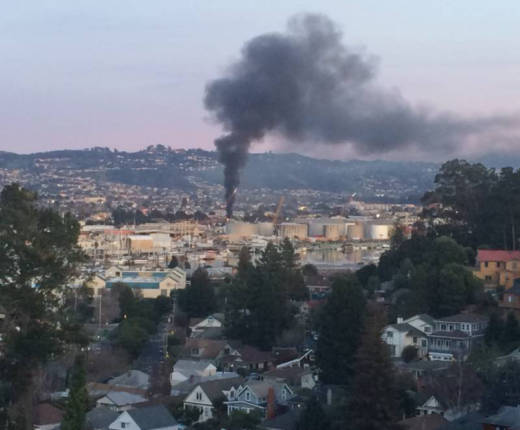"It's a big concern," Zhang said, adding that the report gives only a small snapshot of what was in the air that night.
At a town hall meeting in Richmond last Wednesday, several residents indicated that the smoke made them sick.
"We could smell it in our house," said Bruce Kaplan, a Point Richmond resident. "It irritated my eyes. It's not good to put noxious stuff in the air."
A Sims representative said the 20-foot pile that burned for about 11 hours was made up of refrigerators, stoves, dishwashers and office furniture, among other items.
Sims officials said they do not know what chemicals were in the air the night of fire.
The air agency's lab reports, which analyzed smoke captured within the first two hours of the fire, found benzene levels that peaked at 318 parts per billion. Short-term exposure to the chemical, which is used in paints and gasoline, can cause eye, skin and respiratory tract irritation and, at high levels, unconsciousness -- and, longer term, central nervous system and bone marrow damage, according to the National Institutes of Health.
The lab data showed 111 parts per billion of butadiene, an industrial chemical used in making synthetic rubber. Butadiene is also a known carcinogen.
Zhang said EPA data indicate that the acute or short-term toxicity of butadiene is low. The EPA's hazard summary for the substance says short-term exposure can cause irritation of the eyes, nasal passages, throat and lungs.
The air district reports also showed peak levels of 81 parts per billion of acrylonitrile, a highly toxic compound used in manufacturing plastics, adhesives and synthetic rubber that is "reasonably anticipated to be a human carcinogen," according to the NIH.
EPA research has found the acute toxicity of acrylonitrile -- which can cause mucous membrane irritation, headaches, dizziness and nausea with short-term exposure -- is high.
The cancer risks associated with inhaling butadiene and acrylonitrile are higher than benzene, according to Zhang.
The data also show elevated levels of acetone and toluene, solvents that are not known carcinogens.
A county health department press statement released three days after the Jan. 30 fire noted that the air district and a county hazardous materials response team also measured high particulate readings throughout the night of the fire. The press release notes that smoke particulates can irritate the throat, lungs and eyes.
High benzene and particulate readings came from an air monitor in Point Richmond, the county health department release said.
"There were no other elevated readings of any other chemicals that were analyzed or particulates on any of the other monitors," the department said.
The air district's tests included five samples that measured the presence of 22 chemicals, most in low concentrations.
County health officials, when asked why they didn't include a mention of the other compounds detected by the air district, defended their communication with the community.
"The announcement we prepared focused on the levels of benzene because the levels of the other 21 chemicals were either not detected or detected below a level of concern for short-term exposure," said Marilyn Underwood, the county's environmental health director, in an emailed statement.
"The level of benzene detected in three samples collected near the fire and from one community monitor were above a health comparison value developed by the state for short-term (1 hour) exposure," Underwood said.
Underwood stressed that the department is uncertain about the long-term risks for those exposed to benzene or other chemicals the night of the fire.
Last week, the air district issued two notices of violation against Sims, one for public nuisance and another for illegal open burning. The agency's investigation is ongoing and any settlement associated with the violations is likely years away.
The cause of the fire is under investigation by the Richmond Fire Department.
